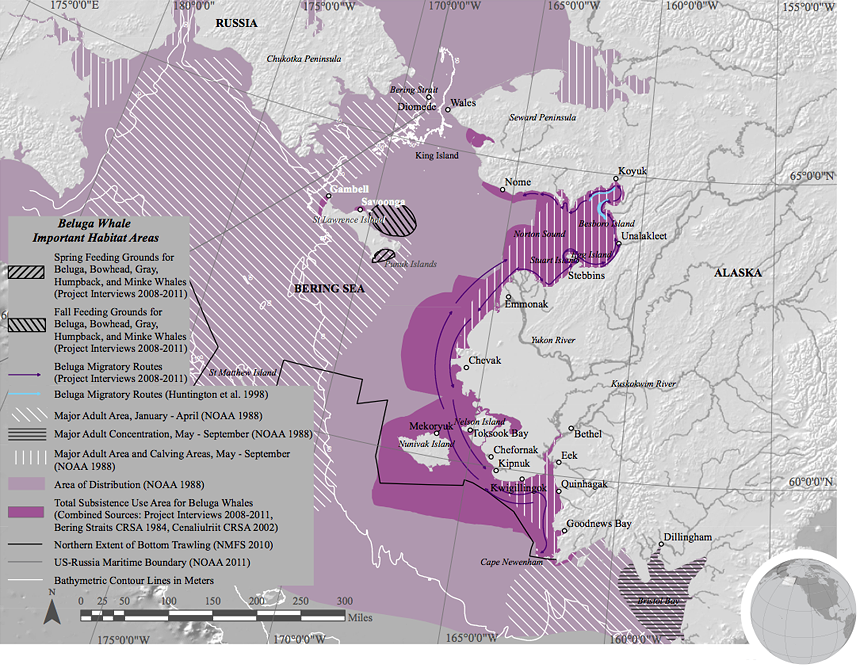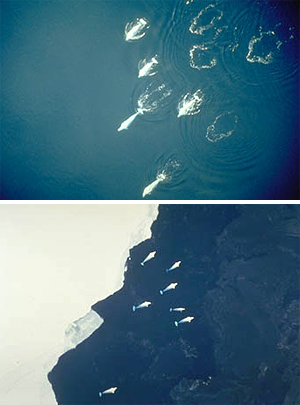Maps: Beluga Whale: Important Habitat Areas

NOTES:
Arrows indicating beluga movement in Norton Sound were generalized from the original source (Huntington et al. 1998). The actual level of detail would not be visible on this map scale.
The shape for Total Subsistence Use Area is partly made up of Cenaliulriit CRSA data that represents all marine mammals collectively.
Biology

Bottom: Beluga whales following leads in pack ice. Photo credit: National Marine Mammal Lab
Central Yup’ik: Cetuaq
St. Lawrence Island Yupik: Puugzaq
Inupiaq: Sisuaq
Scientific: Delphinapterus leucas
Belugas, we get some during the winter time, if we’re lucky...In March or April, winter time and during summer, anytime all year around.20 Herman Hootch – Emmonak
Fall time is best time to hunt. That’s when the muktuk is a lot thicker, when these whales first come out of the Yukon. In the spring, normally they have a lot of young ones.21 Elders and Active Hunters (after group discussion) – Stebbins
We share beluga with the whole village, dry it, freeze it, eat it with stew. Muktuk is pickled or boiled or raw, depending who you have over for dinner. The elders like it raw more than the kids. Kids like to have it boiled with modern condiments.22 Allan Sagoonick – Unalakleet
We see belugas filled with little shrimps and often the water is colored pink from all the shrimp.23 Elders and Active Hunters (after group discussion) – Shaktoolik
The bigger the beluga, the more salmon there is in their stomach. Maybe 12 salmon in a big one. They swallow them whole.24 Elders and Active Hunters (after group discussion) – Elim
Belugas are the most abundant arctic cetacean (whales, dolphins and porpoises) and can be found throughout the Bering, Chukchi, and Beaufort seas. There are five semi-isolated populations in Alaskan waters during the summer months (Cook Inlet, Bristol Bay, Bering Sea, eastern Chukchi and Beaufort Sea). These groups (except Cook Inlet) mix in the fall and winter when all the whales come into the Bering Sea.25
All belugas winter in offshore areas where there are openings in the pack ice. In warmer months the Bering Sea population occupies coastal habitats, often near estuaries and river mouths, while other stocks make extended excursions to the Arctic Basin and along the Beaufort Sea slope. Some populations undertake long seasonal migrations, moving up to 2,000 kilometers (1,242 miles) between winter and summer habitats, while others migrate shorter distances between offshore areas and nearby coastlines.26 In the spring and summer, their movements are closely associated with concentrations of the migratory fish species that they feed on and some follow fish into bays and up rivers.27 Belugas feed on a great variety of fish species, shrimp and also on the occasional benthic invertebrate, squid, or octopus. Indigenous hunters observe that belugas feed heavily on shrimp, herring, salmon, and tomcods.28 Sometimes called “canaries of the sea,” belugas use a repertoire of whistles, chirps and clicks to communicate with other whales and for echolocation used to find prey.29
Other Important Whale Habitats:
Bowhead Whale
Beluga Whale




